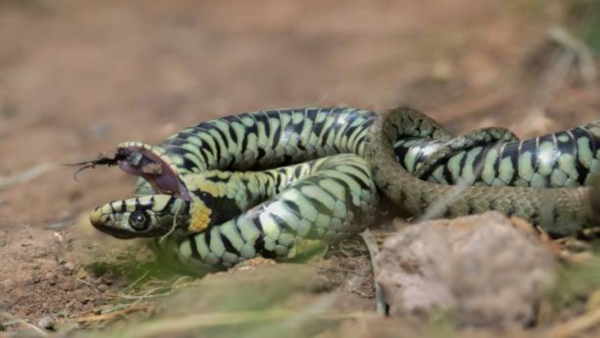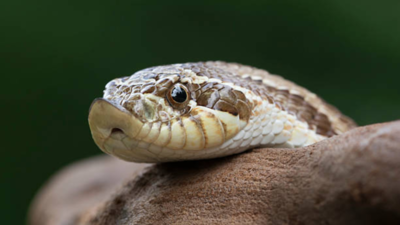Picture this: you’re walking through the woods, and suddenly, there’s a snake in your path. Before panic fully sets in, the snake does something totally unexpected—it flips onto its back, opens its mouth wide, lets its tongue hang out, and just… lies there, dead still. You hesitate. Is it really dead? Or is this snake just being unbelievably dramatic?Welcome to the bizarre, slightly hilarious, and wildly effective world of death-feigning snakes. In the animal kingdom, playing dead—what scientists call “thanatosis”—is a trick used by all kinds of creatures. But snakes? They’ve taken it to a whole new level of performance art.
Dice snakes
Let’s start with one of the best actors in the reptile world: the dice snake. Native to parts of Europe and Asia, these snakes don’t just play dead—they turn the whole scene into a horror film. When threatened, a dice snake will twist onto its back, contort its body, and hang its tongue out like it’s been flattened by a truck. But that’s just the warm-up. Some individuals take it further by smearing themselves with their own poop and musk. Yes, actual self-pooping for effect. And if that isn’t enough, some even bleed from their mouths, a weirdly convincing tactic that makes them look genuinely injured or rotting.This over-the-top combo of limp body, awful stench, and fake gore convinces many predators to look elsewhere for dinner. The logic makes sense—dead or sick animals could carry diseases or taste bad, so it’s safer to leave them be. For the dice snake, all that effort is often worth it. In the wild, it can mean the difference between survival and becoming a bird’s lunch.
Hognose snakes
If dice snakes are horror film extras, the eastern hognose snake is the main character in a full-blown snake soap opera. Native to North America, these snakes put on what can only be described as an acting masterclass. Their performance usually starts with intimidation—flattening their necks to mimic cobras, hissing loudly, and doing dramatic false strikes to scare you off. But if the predator (or human) doesn’t back down, it’s time for plan B: death.

The hognose flips onto its back, gapes its mouth open, lets its tongue dangle, and then releases a foul-smelling musk or sometimes even a fluid that looks like it’s oozing from wounds. It might even twitch a few times like it’s in its final throes. If someone tries to flip it upright, it will roll right back onto its back, like, “Nope! I’m still dead, leave me alone!” Some snakes can stay in this state for 30 to 45 minutes, remaining still until they’re sure the threat has passed.This act is so convincing that hikers and snake enthusiasts often think the snake has actually died of fright. Nope—it’s just pulling off one of the oldest tricks in nature’s playbook.
Grass snakes and other masters of the art
Across Europe, the grass snake takes a similar approach. It prefers wet habitats and plays dead with a combination of rolling belly-up, hanging its tongue out, and releasing an unbelievably nasty-smelling substance from its cloaca. These snakes might not go quite as far as bleeding from the mouth, but their dedication to the role still lands them a spot in the top tier of snake performers.Other species like the common kingsnake and the rinkhals (a relative of the spitting cobra) also use death-feigning. The kingsnake does it all: tail rattling, defecating, flopping onto its back, and lying still like a cold corpse. Meanwhile, the rinkhals adds a snake-specific twist—spraying venom and playing dead at the same time. Even some slug snakes, like the blunthead slug snake, are known to roll up and freeze when they feel threatened, hoping their lifeless pose buys them a second chance at life.
Why bother playing dead?
So what’s the science behind this snaky behavior? It turns out, predators are generally not fans of motionless, gross-smelling, possibly dead food. They prefer prey that’s alive, clean, and relatively safe to eat. That’s why faking death can be such a powerful defense tactic.In nature, standing still or going limp isn’t always about freezing from fear. It can be a calculated strategy. By appearing lifeless, the snake removes the thrill of the hunt. Add in the smell of feces or the sight of fake blood, and many predators just decide it’s not worth the trouble—or the potential illness.Interestingly, not all snakes play dead in the same way, or at all. Factors like age, body size, past experiences, or even whether a snake is carrying eggs can affect its decision to go full drama. Some younger snakes avoid bleeding from the mouth because it could actually make them more vulnerable. Others might choose to fight or flee depending on the situation.
The weird, wild power of performance
From a human perspective, these death acts can be startling, comical, or downright gross. But for the snake, it’s a matter of survival. And the fact that different species have evolved such convincing performances shows how effective this behavior really is. In a way, these snakes are engaging in a complex psychological game with their predators—one that often ends with the predator confused, the snake alive, and everyone going their separate ways.Videos of these “zombie snakes” regularly go viral online, surprising people who assume the animals are either sick or dying. But once you know the trick, you can appreciate the ingenuity. The next time you see a snake pull one of these stunts, don’t panic—and don’t assume the worst. Chances are, it’s just faking its death like a true reptilian drama king.Snakes that pretend to be dead might sound like a strange curiosity, but they’re a perfect example of nature’s creativity. When brute strength or venom aren’t on the menu, cleverness and a bit of gross theater can be just as powerful. These animals prove that sometimes, the best way to survive is to throw yourself on the ground, stick out your tongue, and play dead like your life depends on it—because, honestly, it does.
